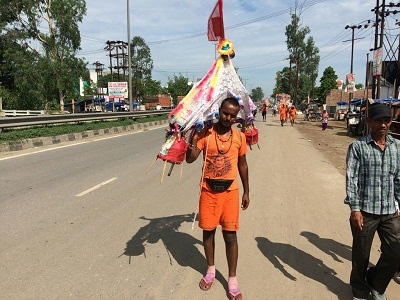( ျမန္မာဘာသာ )
In mid-July heat, encountering people dressed in orange, walking very energetically on the road is something unusual for me.
Men, women, teenagers and young children, all wearing a similar orange one looks to be very beautiful to me and its very eyes catching too.
When I look at them closely, I noticed that they are not just walking. They are carrying something on their shoulders. What exactly is this? Well, they are carrying yoke or pole.
A single pole carry covered water-pots by balancing the middle of the pole on one or both shoulders. These poles are usually made of bamboo and almost every pole is highly decorated. These very colorful and decorative designs truly represent “Colorful India”.
Some people are walking around in a cart and some are carrying water bottles on their body instead of pole.
I am just very interested to know what exactly this is…

This festival is called Kanwar Yatra. It’s celebrated yearly in Northern India during Monsoon (July or August). Direct translation would be Kanwar is a single bamboo pole carry water-pots across shoulders and Yatra means a journey or procession.
It is an annual pilgrimage of devotees of Shiva (Hindu God) comes out from their city or village, walk and get together at the Ganga’s Sources and fetch holy waters from Ganga River to bring it back to Shiva temples in their city of origin.
(There have 3 main Gods in Hinduism, Brahma-the creator, Vishnu-protector and Shiva-the destroyer)

Millions of devotees of Shiva who come from different parts, to Hindu Pilgrimage places such of Haridwar, Gaumukh, Gangotri and Sultanganj and get together, worship there, take holy water and return to their residences and offer donations to Shiva.
The participants in this pilgrimage, who walk with passion, look very active and very enthusiastic. It looks very infectious to me.
Participants come from different places, from remote villages to big cities. On an average a participant walks around 500km to 800km by foot to complete this pilgrimage.

Another interesting thing is that individual participant has different commitments. For example, some people commit that they will go, take water and come back within 2days, some 3days or 4days, some people carry their old family members on the yoke, and some commits not to sleep or rest.
Before 1990, only hundreds of believers gathered for this celebration. But now it became tens of thousands of people who join for this long distance pilgrim walk. So every year in mid-July, government authority divert the roads and reserve for those who walk.

There have a lot of pavilions along the route that people donate food, medicine and for taking rest.
When they stop in a pavilion, they are not supposed to keep their yoke on the ground as a symbol of respect to the holy Ganga water which they are carrying. Because of this, outside every pavilion they make bamboo stands to hang the yoke.


By the changing of era, some people use vehicles such as bikes, motorcycles, cars and trucks. They are also going to Ganga usually in groups made of family, friends and or neighbors and return to their residences.


Everything has good and bad parts so does this festival. It causes heavy traffic jams almost everywhere and some non-participants also think that this is less beneficial and more bothersome.
The government seriously monitors this pilgrim walk that participating tens of thousands of people. The government is taking caring for the concern of safety, to minimize accidents and crimes and controlling heavy traffic too.

Among the participants, some are very young and they start playing pop and electro music along the way. They play music the whole night and even dancing, something really enjoyed by young pilgrims. Elder participants complaint about the dilution of traditional values because of such music. Local peoole complaint about the noise and disturbance. Government authority and polices complaint about crowd management, law and order. Well, this event doesn’t make everyone as happy as it seems.

Millions of participants in this pilgrimage seem exhausted but their strong commitments, belief and faith make them like “legendary mythical travelers”….


Nice to read about this interesting festival.Is this festival only celebrated in North India ? I heard that they also celebrate this in west bengal ?
Thanks for your comment.
I think it’s also celebrate in west bengal but I don’t have too much information about it.
I actually snickered out loud about when reading about doing battle with my water bottle. I feel so much more Grok-like now toting my SS water bottle across campus now! Thanks, Mark!